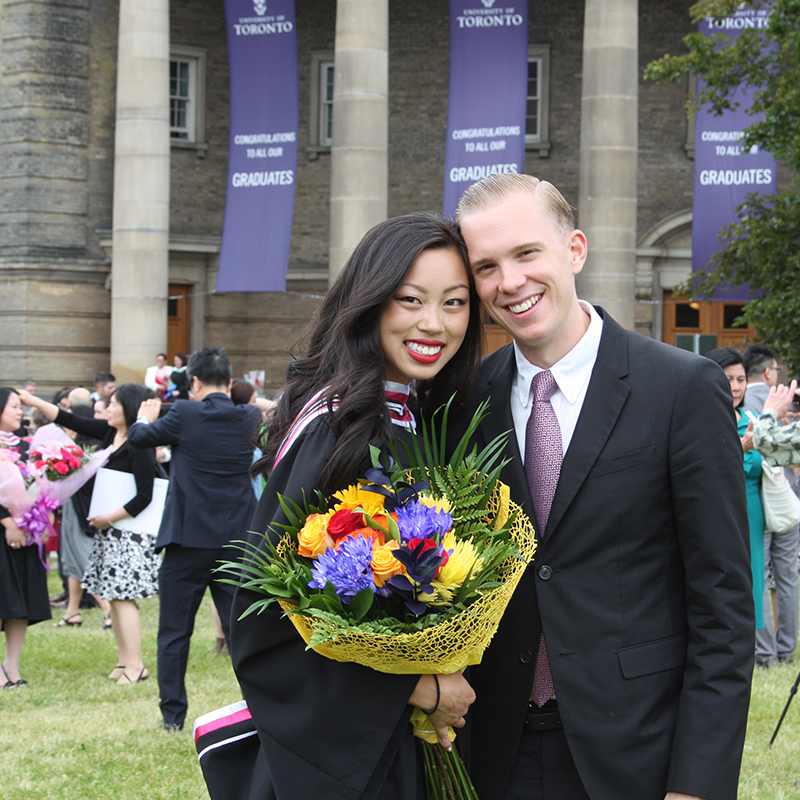Two couples tell us the cost of being in a long-distance relationship
By: Rebecca Lee on February 8, 2017
Your twenties are tough enough as it is. You’re busy navigating debt, salary, savings, and all that other scary financial stuff for the first time.
Add in a long-distance relationship, and suddenly you’ve got a lot more to figure out, like how often can you afford to see your significant other? How long will you be apart? Is it even worth it?
We found two couples to get the answers. Their stories are different, but their challenge is the same — being in a relationship separated by distance, and the costs that come with it.
Dating across cities

Names: Caitee Cheung and Sean MacPherson
Together for: 2 years
Ages: 24 (her), 26 (him)
Where: Toronto (her), St. Catharines, Ont. (him)
Distance apart: 112 km or a 1.5 hour drive away
Caitee and Sean, two occasional teachers with a bunch of other side gigs, have done the long-distance thing before, back when they were in teacher’s college and first started dating.
They actually met three months before Caitee boarded a plane to Seoul for a short teaching stint. Adventurous and (at the time) unattached, she had applied to be an SAT prep instructor in Korea, instead of looking for a more conventional summer gig in Toronto.
Before she left, Sean and Caitee had tentative plans of meeting up in Indonesia, but life — or more accurately, tight funds and school deadlines — got in the way. Caitee hadn’t really saved much while she was in Korea (too much soju?). Meanwhile, Sean’s money was going towards a certification he was finishing, and he couldn’t swing the $1,300 plane ticket to visit Caitee.
Luckily, in 2015, they both found themselves back in Toronto, the long-distance challenges were a thing of the past.
Now, two graduations and two years of dating later, they’re apart again. About six months ago, Sean moved to St. Catharines for work while Caitee stuck it out in Toronto for job prospects.
“He moved away to better his career and I was very encouraging of it,” says Caitee. “There weren’t a lot of positions here that would offer the pay he was looking for and give him benefits. Being a teacher, that’s really difficult to get.”
Their long-distance relationship costs
Fortunately, travelling between Toronto and St. Catharines is easy (and affordable) enough because Caitee and Sean both have cars. The journey takes about $50 of gas for a return trip in Caitee’s Lexus SUV or about $40 in Sean’s Toyota Corolla. Fortunately, filling up in St. Catharines is a hell of a lot cheaper than filling up in the city.
They spend their weekends together eating (as all the best couples do). Usually Sean drives to Toronto, where their lunch dates average about $40. Since they don’t see each other every week, or even every weekend, they like to splurge on dinners, which can cost north of $60. They’re also really into Toronto’s world class brunch and coffee shop scene.
Meals are generally split between them, but because Sean is making more money (hence the move!), he sometimes just picks up the whole bill.
I would actually say I’ve saved more of my money since he moved away, and I think he has as well
But other than some hefty car expenses, they admit this distance is manageable, relationship-wise and finance-wise. Especially since Sean’s move to St. Catharines, much like Caitee’s to Korea, was in the name of a work opportunity that they both wanted the other to experience.

Now they’re both hustling hard, albeit apart, in multiple education roles (at least three each!), and that’s just fine for them. If anything, their long-distance relationship has actually been kind of great for their careers and their savings. But they stop short of endorsing long-distance relationships to get ahead in life.
“I would actually say I’ve saved more of my money since he moved away, and I think he has as well,” Caitee says. “But I’m not going to say, hey, everyone! Get in a long-distance relationship ‘cause it’s going to save you a lot of money!”
What the future looks like
Open, undecided, and with a lot of new money lessons to be had.
As of now, Sean and Caitee are long-distance indefinitely. They don’t know where their careers will lead them next, but they always keep an eye out for opportunities that’ll land them back in the same city.
In the meantime, they’re starting to handle their first big money matter together: their teacher’s pensions. The upside of dating someone in the same career as you is that you get to figure out things together, even if you’re apart.
Dating across countries

Names: Nicole and Patrick RoDee
Together for: 6 years
Ages: 24 (her), 25 (him)
Where: Markham, Ont. (her), San Diego (him)
Distance apart: 4,186 km or a 5-hour flight away
Nicole and Patrick — who are just as sunny as their photo — used to consider their semester breaks apart to be ‘long distance’. Back then, Nicole would return home to Markham, and Patrick, originally from Virginia, would stay in Kingston.
Then Patrick graduated and moved back to the states to begin his life and career in San Diego, his dream city. An internship at a local web company was his chance to finally make the big move.
And Nicole, still finishing her concurrent-education program in Canada, was all for it: “I told him to do it! It was a great opportunity for him to try something new and pursue something he’d always had in mind.”
Now, with a five-hour plane ride between them and a three-hour delay between good morning texts, Nicole and Patrick were officially in a hard-core, long-distance relationship.
Their long-distance relationship costs
Between Kingston and Markham, visits to see each other were as simple as a ride with a friend or a bus into town. Between Ontario and California, there was a plane to catch.
Airfare costs ranged from $350 to $650 CAD for a round trip. Then there were luggage fees ($25-$35) and travel insurance costs (example: $120 for three weeks). Plus, Nicole chipped in for Patrick’s living expenses whenever she stayed with him — that started at $100 USD and quickly dwindled to $0 when he stopped accepting her cash. What’s a little rent money between long-distance sweethearts, anyway?
Airfare costs ranged from $350 to $650 for a round trip. Then there were luggage fees ($25-$35) and travel insurance costs ($120)
Now take those travel costs and multiply by five — the number of trips they made the first year of Patrick’s move. Their cross-continent relationship was racking up bills in the thousands. And that’s before any of the extras (think shipping fees for gifts, long-distance minutes, etc.).
Nicole, who was working towards a role in education, earmarked her earnings for these trips to see Patrick. However, she was also lucky enough to get help from her parents, who she was still living with.
Patrick was also benefitting from a little mom-and-pop financial support, but his own disposable income was tight until he graduated from intern to full-time at his company. Now he had a little more cash to visit Nicole and pay for a shiny little something: an engagement ring.
So one summer day in 2015, during a visit to the Toronto Zoo (where they had their first date), Patrick proposed.
Financing the big move
Getting engaged meant two things: their long-distance stint was nearing an end and the transition was going to be ex-pen-sive.

Nicole moved to San Diego, but the visa process was neither cheap nor easy.
“We both had money saved up for this and both our parents helped out, too,” says Patrick. “We’d say it was a fair 50/50 split between our finances and our parents’ for visa paperwork and the process.”
That visa paperwork, by the way, cost them about $2,100. And that doesn’t include the printing and shipping costs, or the fact that Nicole had to travel to Montreal for the interview.
While Nicole’s visa application was being processed, they also had to start figuring out their finances. Not only were they were getting married (hello, joint accounts!), they were doing it on a fiancé’s visa. Everything had to be done right. A lot of it also had to be done while they were still 4,186 km away from one another.
Patrick went to a credit union and opened up a new account for both of them. Meanwhile, Nicole transferred money from her Canadian account into his U.S. account, which is now officially a joint bank account, thank you very much. By bringing over her savings, they had a little more money to work with, both for the wedding and for their start in San Diego.
When they got married, Nicole also gained health and life insurance coverage through Patrick’s work benefits, an important plus since she couldn’t actually work right away and earn her own — “Luckily, Patrick has a salary that allows us to live comfortably in the meantime until I can get a job. Yay for having a cute studio apartment!”
What the future looks like
Two income streams, two careers, and one new home. Hopefully.
Nicole just got her social security number and her work authorization, which means she can now officially work in California. She’s excited to start her career in San Diego and her and Patrick are saving for the next big things: a car, a home, and travel.
Patrick’s thinking about those things, too, but as long as he gets to buy his $6 tacos and enjoy their new life in San Diego, he’s already pretty happy.

Photos courtesy of Leaf Wedding Photography


